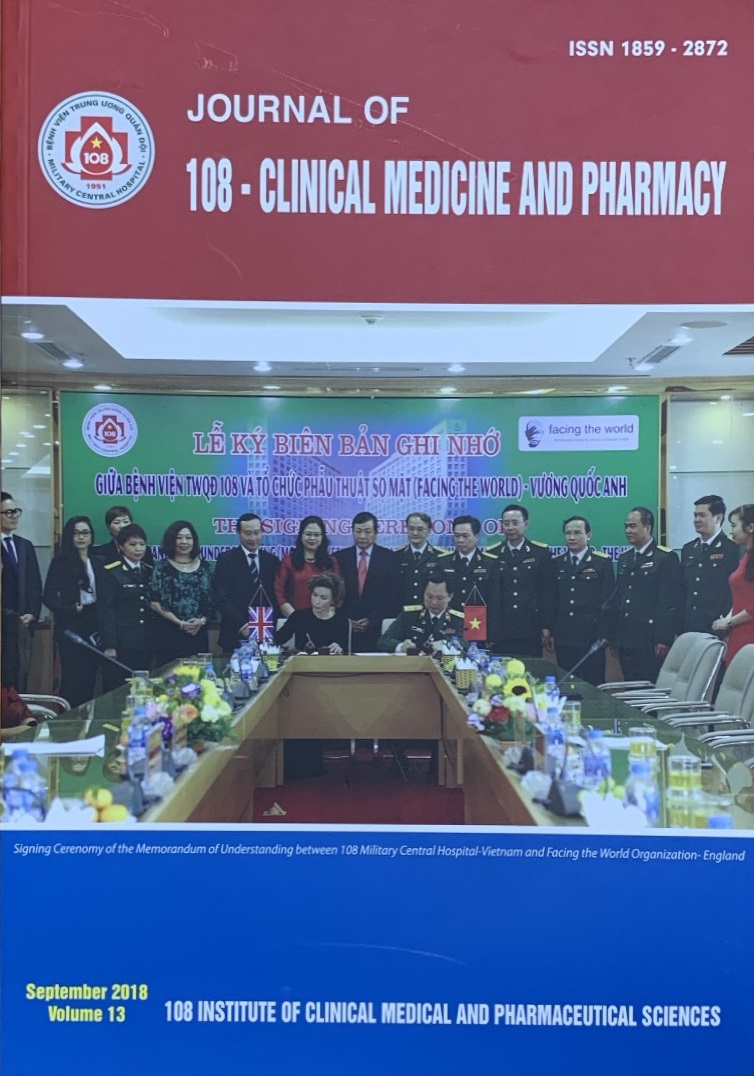Results of percutaneous nephrolithotomy for the treatment of renal stones larger than 2cm
Main Article Content
Abstract
Objective: This study aims to evaluate the results of percutaneous nephrolithotomy (PCNL) for the treatment of renal stones larger than 2cm. Subject and method: A prospective study carried out on 139 patients with renal stones larger than 2cm treated by percutaneous nephrolithotomy (PCNL) from December 2009 to December 2016 at 108 Military Central Hospital. Result: Among 139 patients studied, the mean age of patients was: 50.6 ± 10.7 years. The mean stone size was 3.97 ± 1.46cm. The mean operative time was 107.8 ± 31.1 minutes. The PCNL procedure was successfully completed in all patients. The success rate (stone-free status) was 77% (107/139). The mean post-operative hospital stay was 6.2 ± 2.7 days. The overall complications were observed in 22.3% of cases (31/139). According to the Clavien-Dindo classification: Grade 1 (12.9%), grade 2 (7.2%), grade 3 (2.8%), grade 4 (0.7%), grade 5 (0%). Conclusion: PCNL is a minimally invasive, safe and effective choice of treatment for renal stone larger than 2cm with high success rate.
Keywords: Renal stones, percutaneous nephrolithotomy.
Article Details
References
2. Trương Văn Cẩn (2014) Phẫu thuật lấy sỏi thận qua da tại Bệnh viện Trung ương Huế. Tạp chí Y Dược học, Đặc san Hội nghị Khoa học thường niên lần thứ VIII - Hội Tiết niệu Thận học Việt Nam, tr. 40-46.
3. Võ Phước Khương, Vũ Lê Chuyên (2012) Lấy sỏi qua da với đường vào thận từ đài dưới trong điều trị sỏi thận phức tạp. Y học Thành phố Hồ Chí Minh, Chuyên đề Thận niệu, Phụ bản của tạp chí 16(3), tr. 204-211.
4. Rosette JJ, Opondo D et al (2012) Categorisation of complications and validation of the Clavien score for percutaneous nephrolithotomy. Eur Urol 62(2): 246-255.
5. C Türk TK, Petrik A, Sarica K, Seitz C, Straub M, Traxer O (2010) Guidelines on urolithiasis, European Association of Urology 20.
6. David A, Leavitt M et al (2016) Strategies for nonmedical management of upper urinary tract calculi campbell-wash urology. Vol. 2, 11th, Elsevier, Philadenphia: 1235-1259.
7. Raman JD, Bagrodia A et al (2010) Residual fragments after percutaneous nephrolithotomy: Cost comparison of immediate second look flexible nephroscopy versus expectant management. J Urol 183(1): 188-193.
8. Rizvi SAH, Hussain M et al (2017) Surgical outcomes of percutaneous nephrolithotomy in 3402 patients and results of stone analysis in 1559 patients. BJU Int 120(5): 702-709.
9. Rosette J, Assimos D et al (2011) The clinical research office of the endourological society percutaneous nephrolithotomy global study: Indications, complications, and outcomes in 5803 patients. J Endourol 25(1): 11-17.
10. de Souza Melo PA, Vicentini FC et al (2018) Outcomes of more than 1,000 percutaneous nephrolithotomies and validation of Guy's stone score. BJU Int 121(4): 640-646.
 ISSN: 1859 - 2872
ISSN: 1859 - 2872
